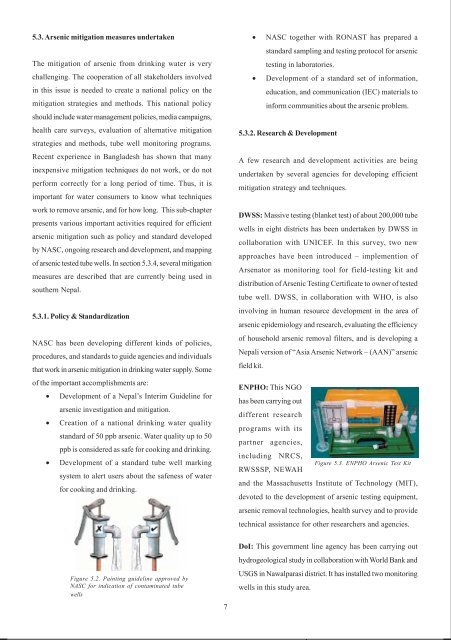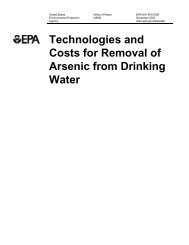The State of Arsenic in Nepal - 2003 - Harvard University ...
The State of Arsenic in Nepal - 2003 - Harvard University ...
The State of Arsenic in Nepal - 2003 - Harvard University ...
Create successful ePaper yourself
Turn your PDF publications into a flip-book with our unique Google optimized e-Paper software.
5.3. <strong>Arsenic</strong> mitigation measures undertaken<br />
<strong>The</strong> mitigation <strong>of</strong> arsenic from dr<strong>in</strong>k<strong>in</strong>g water is very<br />
challeng<strong>in</strong>g. <strong>The</strong> cooperation <strong>of</strong> all stakeholders <strong>in</strong>volved<br />
<strong>in</strong> this issue is needed to create a national policy on the<br />
mitigation strategies and methods. This national policy<br />
should <strong>in</strong>clude water management policies, media campaigns,<br />
health care surveys, evaluation <strong>of</strong> alternative mitigation<br />
strategies and methods, tube well monitor<strong>in</strong>g programs.<br />
Recent experience <strong>in</strong> Bangladesh has shown that many<br />
<strong>in</strong>expensive mitigation techniques do not work, or do not<br />
perform correctly for a long period <strong>of</strong> time. Thus, it is<br />
important for water consumers to know what techniques<br />
work to remove arsenic, and for how long. This sub-chapter<br />
presents various important activities required for efficient<br />
arsenic mitigation such as policy and standard developed<br />
by NASC, ongo<strong>in</strong>g research and development, and mapp<strong>in</strong>g<br />
<strong>of</strong> arsenic tested tube wells. In section 5.3.4, several mitigation<br />
measures are described that are currently be<strong>in</strong>g used <strong>in</strong><br />
southern <strong>Nepal</strong>.<br />
5.3.1. Policy & Standardization<br />
NASC has been develop<strong>in</strong>g different k<strong>in</strong>ds <strong>of</strong> policies,<br />
procedures, and standards to guide agencies and <strong>in</strong>dividuals<br />
that work <strong>in</strong> arsenic mitigation <strong>in</strong> dr<strong>in</strong>k<strong>in</strong>g water supply. Some<br />
<strong>of</strong> the important accomplishments are:<br />
• Development <strong>of</strong> a <strong>Nepal</strong>’s Interim Guidel<strong>in</strong>e for<br />
arsenic <strong>in</strong>vestigation and mitigation.<br />
• Creation <strong>of</strong> a national dr<strong>in</strong>k<strong>in</strong>g water quality<br />
standard <strong>of</strong> 50 ppb arsenic. Water quality up to 50<br />
ppb is considered as safe for cook<strong>in</strong>g and dr<strong>in</strong>k<strong>in</strong>g.<br />
• Development <strong>of</strong> a standard tube well mark<strong>in</strong>g<br />
system to alert users about the safeness <strong>of</strong> water<br />
for cook<strong>in</strong>g and dr<strong>in</strong>k<strong>in</strong>g.<br />
• NASC together with RONAST has prepared a<br />
standard sampl<strong>in</strong>g and test<strong>in</strong>g protocol for arsenic<br />
test<strong>in</strong>g <strong>in</strong> laboratories.<br />
• Development <strong>of</strong> a standard set <strong>of</strong> <strong>in</strong>formation,<br />
education, and communication (IEC) materials to<br />
<strong>in</strong>form communities about the arsenic problem.<br />
5.3.2. Research & Development<br />
A few research and development activities are be<strong>in</strong>g<br />
undertaken by several agencies for develop<strong>in</strong>g efficient<br />
mitigation strategy and techniques.<br />
DWSS: Massive test<strong>in</strong>g (blanket test) <strong>of</strong> about 200,000 tube<br />
wells <strong>in</strong> eight districts has been undertaken by DWSS <strong>in</strong><br />
collaboration with UNICEF. In this survey, two new<br />
approaches have been <strong>in</strong>troduced – implemention <strong>of</strong><br />
Arsenator as monitor<strong>in</strong>g tool for field-test<strong>in</strong>g kit and<br />
distribution <strong>of</strong> <strong>Arsenic</strong> Test<strong>in</strong>g Certificate to owner <strong>of</strong> tested<br />
tube well. DWSS, <strong>in</strong> collaboration with WHO, is also<br />
<strong>in</strong>volv<strong>in</strong>g <strong>in</strong> human resource development <strong>in</strong> the area <strong>of</strong><br />
arsenic epidemiology and research, evaluat<strong>in</strong>g the efficiency<br />
<strong>of</strong> household arsenic removal filters, and is develop<strong>in</strong>g a<br />
<strong>Nepal</strong>i version <strong>of</strong> “Asia <strong>Arsenic</strong> Network – (AAN)” arsenic<br />
field kit.<br />
ENPHO: This NGO<br />
has been carry<strong>in</strong>g out<br />
different research<br />
programs with its<br />
partner agencies,<br />
<strong>in</strong>clud<strong>in</strong>g NRCS,<br />
Figure 5.3. ENPHO <strong>Arsenic</strong> Test Kit<br />
RWSSSP, NEWAH<br />
and the Massachusetts Institute <strong>of</strong> Technology (MIT),<br />
devoted to the development <strong>of</strong> arsenic test<strong>in</strong>g equipment,<br />
arsenic removal technologies, health survey and to provide<br />
technical assistance for other researchers and agencies.<br />
Figure 5.2. Pa<strong>in</strong>t<strong>in</strong>g guidel<strong>in</strong>e approved by<br />
NASC for <strong>in</strong>dication <strong>of</strong> contam<strong>in</strong>ated tube<br />
wells<br />
7<br />
DoI: This government l<strong>in</strong>e agency has been carry<strong>in</strong>g out<br />
hydrogeological study <strong>in</strong> collaboration with World Bank and<br />
USGS <strong>in</strong> Nawalparasi district. It has <strong>in</strong>stalled two monitor<strong>in</strong>g<br />
wells <strong>in</strong> this study area.

















